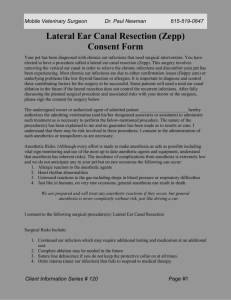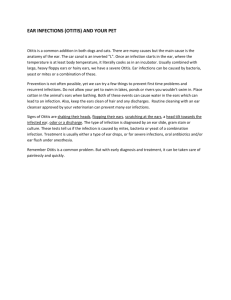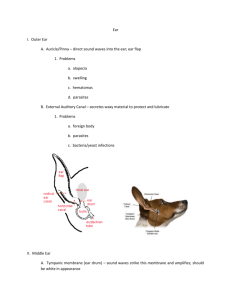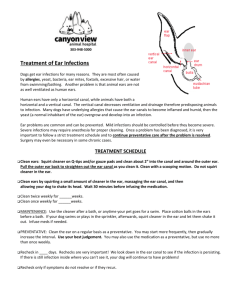Allergic Dermatitis – Part 1
advertisement
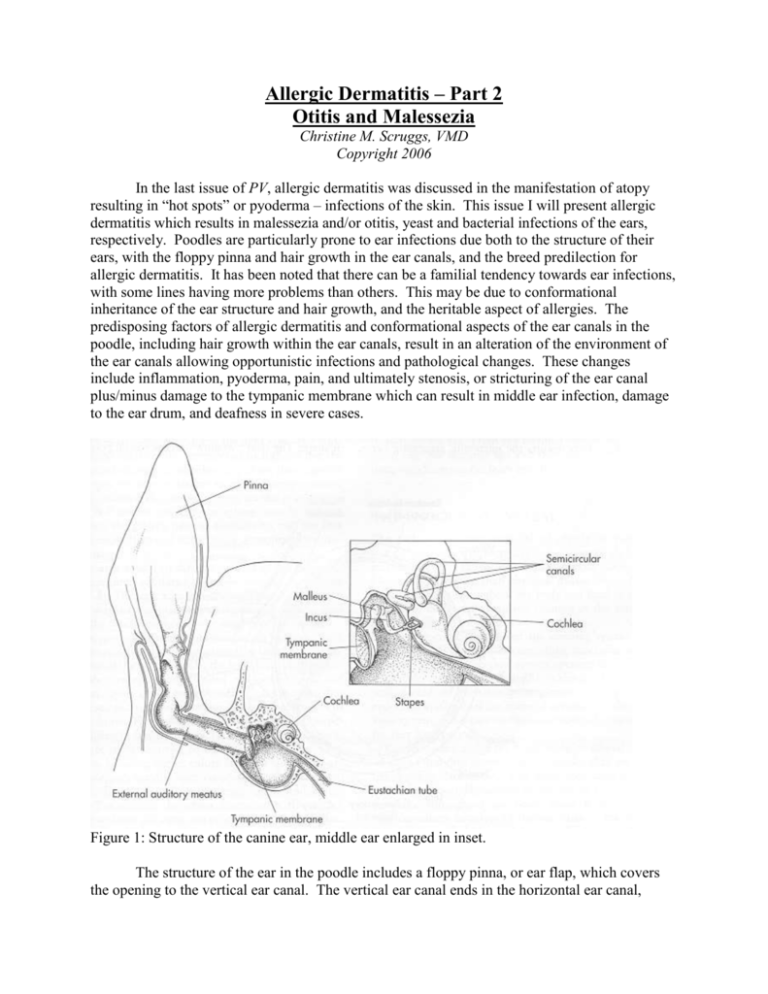
Allergic Dermatitis – Part 2 Otitis and Malessezia Christine M. Scruggs, VMD Copyright 2006 In the last issue of PV, allergic dermatitis was discussed in the manifestation of atopy resulting in “hot spots” or pyoderma – infections of the skin. This issue I will present allergic dermatitis which results in malessezia and/or otitis, yeast and bacterial infections of the ears, respectively. Poodles are particularly prone to ear infections due both to the structure of their ears, with the floppy pinna and hair growth in the ear canals, and the breed predilection for allergic dermatitis. It has been noted that there can be a familial tendency towards ear infections, with some lines having more problems than others. This may be due to conformational inheritance of the ear structure and hair growth, and the heritable aspect of allergies. The predisposing factors of allergic dermatitis and conformational aspects of the ear canals in the poodle, including hair growth within the ear canals, result in an alteration of the environment of the ear canals allowing opportunistic infections and pathological changes. These changes include inflammation, pyoderma, pain, and ultimately stenosis, or stricturing of the ear canal plus/minus damage to the tympanic membrane which can result in middle ear infection, damage to the ear drum, and deafness in severe cases. Figure 1: Structure of the canine ear, middle ear enlarged in inset. The structure of the ear in the poodle includes a floppy pinna, or ear flap, which covers the opening to the vertical ear canal. The vertical ear canal ends in the horizontal ear canal, which is similar in structure to the horizontal canal of the human ear; the combination of the vertical and horizontal canals look like an “L” shape lying down, as seen in Figure 1. The horizontal canal ends in the tympanic membrane, which covers the delicate structures of the middle ear, commonly known as the ear drum. It can also be seen that in cleaning the ear canals, it is nearly impossible to puncture or damage the ear drum, unless one sticks an object (cotton swab, etc.) both down and then around the bend of the connection between the two canals. It is, therefore, quite safe to clean the vertical canal by penetrating as deeply as possible straight down the canal without “turning the corner” into the horizontal canal. Of course, it is also quite difficult to completely clean both vertical and horizontal canals completely when there is an infection, as the horizontal canal is sequestered from the rest of the environment by the structure of the ear. The skin of the ear, which covers the pinna and down into the ear canals in the dog, is an extension of the rest of the skin which covers the entire body. Skin itself is a huge organ, and is one continuous entity, although many people do not think of it this way. Therefore, what happens to the skin on the rest of the body can also happen in the ear canal. If a poodle is prone to allergies, this may manifest in infections within the ear canals, rather than as “hot spots” on other parts of the skin outside of the ears. Infections include otitis resulting from bacterial organisms, and those resulting from yeast or fungus, otherwise known as malessezia. The difficulty in resolving these infections can be seen in the case to be presented, that of a 10 year old, female spayed standard poodle named Orianna. This is a true case that was recently seen at my hospital, and ultimately required surgical intervention. Orianna was approximately 5 years old when she first started having ear problems. Initially, only one ear was affected, and clinical signs included pruritis (itching), brown discharge, inflammation, and head shaking. The veterinarian that saw her at that time prescribed topical medication, including antifungal and antibiotic ointments, and ear cleaning. This initial intervention seemed to work at first, and Orianna would have a recurrence of her symptoms a few times a year, which would resolve with minor treatment. As time went on the infections became more frequent, and more severe. Typical lab work, including a chemistry panel and T4 thyroid test, were normal. Orianna’s veterinarian began prescribing oral medications in addition to topical medications. Again, initially she would respond well, and the infections would resolve within a few weeks. Unfortunately, as time went on, the infections would return, and become more difficult to resolve. Her veterinarian performed culture and sensitivity testing, and changed antibiotics appropriately as indicated by the tests. Her owner was not offered a dermatology consult, or allergy testing for environmental allergens. A thyroid panel was performed and found normal, and food allergy testing was negative. While the infections had originally been limited to one ear, they eventually spread to the other ear. Several years had passed and by this time Orianna lived with nearly constant infections and discomfort. Each treatment that was attempted would work for awhile, and then the bacteria would become resistant and “take over” once again. Eventually she became so painful that it was nearly impossible to clean her ears, and sedation was required to flush her ears from the detritus which built up in the ear canals. The veterinarian told Orianna’s owner that nothing more could be done, that “she had a resistant staph infection and it would never get better.” At this point, her owner wondered over Orianna’s quality of life, as she seemed constantly uncomfortable and very painful when anyone touched her ears, and she was continually shaking her head and crying. Orianna came to my clinic for a second opinion. Her owner had heard that I had had a similar problem with one of my own standard poodles, and that I had ultimately decided on surgical intervention, after one year of many different treatments, including food allergy trials, a complete allergy panel and a dermatology consult. When Orianna presented to my clinic she had copious odiferous black discharge from both ear canals, and I could not even examine or clean her ears without sedation. I discussed a consult with a dermatologist, but it was ultimately decided that her condition had deteriorated past the point of the likelihood of successful medical intervention. We performed a culture and sensitivity on both ears, which resulted in a highly resistant Pseudomonas aeruginosa bacterial infection. This is a gram negative aerobic rod that is a ubiquitous opportunistic pathogen which can affect almost any compromised tissue. Pseudomonas is also extremely adaptable, and will mutate to become resistant to many antibiotics within a short period of time. “Only a few antibiotics are effective against Pseudomonas, including fluoroquinolones, gentamicin and imipenem, and even these antibiotics are not effective against all strains. The futility of treating Pseudomonas infections with antibiotics is most dramatically illustrated in cystic fibrosis patients, virtually all of whom eventually become infected with a strain that is so resistant that it cannot be treated.” (Todar’s Textbook of Bacteriology, 2004) Orianna’s strain of Pseudomonas a. was sensitive to one of the stronger and newer fluoroquinolones, marbofloxacin (trade name Zeniquin). I prescribed this antibiotic for Orianna along with scheduling a procedure for sedation to flush her ear canals and “pack” her ears with an antimicrobial paste. This procedure was intended to decrease the bacterial load on her ears in preparation for surgery. While the Pseudomonas a. infection would most likely mutate to become resistant to marbofloxacin, there was another way to decrease the bacterial load permanently – that was to change the environment of the ear canal to make it less hospitable to the bacterial population and ultimately lead to decrease or destruction of the organisms. Pseudomonas a. prefers a moist environment. The only way to decrease the moisture gathering in Orianna’s ear canals at this point was to surgically remove the vertical ear canal, leaving the horizontal ear canal open to the environment. Figure 2. Appearance of the ear after removal of the vertical canal and reconstruction of the remaining cartilage layers. The horizontal canal now has free circulation with air, and remains dry and inhospitable to Pseudomonas a. The surgical procedure is often referred to as a “Zepp” procedure. By removing the vertical ear canal, the area which retains the most moisture in the canals is now open to free circulation of air, resulting in a drier environment which is much less appealing to pseudomonas a. Removal of the vertical canal (Zepp procedure) also results in removing much of the hair growth within the canals which is exacerbating the condition, along with making cleaning of the ears easier and more accessible. Dr. David Holt, chief of surgery of the University of Pennsylvania School of Veterinary Medicine writes that the Zepp surgery is a “…straightforward procedure that practitioners should feel quite comfortable performing. It was originally described by Dr. Zepp in 1949, and so is often referred to as a [Zepp] procedure. The key to success for this procedure is selecting the appropriate candidate for the surgery. For the procedure to be successful, the animal should have minimal changes to the horizontal ear canal, and underlying skin disease that can be controlled in the long term. Animals with primary skin conditions that are difficult to control (Cocker Spaniels with primary seborrhea and dogs with some atopic conditions) have a higher risk of failure after lateral wall resections than other dogs. This procedure reflects the lateral wall of the vertical portion of the external ear canal ventrally, exposing the horizontal ear canal. The procedure effectively shortens the ear canal length, allowing better drainage of horizontal canal and easier administration of medication. It also changes the microclimate in the horizontal canal, decreasing temperature and humidity, making bacterial infection less likely.” (Holt, DVM News Magazine, 2001) In Orianna’s case, the procedure was done on both ears, with good success. She no longer shakes her head incessantly while crying, and her ears have minimal to no discharge and no odor. She is much more comfortable, and her owner reports that her quality of life is back to normal. When otitis and malessezia has progressed to the point of surgery as in Orianna’s case, there is often no other alternative for success. While the Zepp procedure is a relatively simple one, it does require a surgeon with experience, and ability to reconstruct the remaining ear canal to provide adequate drainage and access. It also requires a moderate amount of pain management and commitment on the part of the owner, to be sure the sutures are not disturbed and the dog is not in any distress. This procedure will not affect hearing, and is much preferred over the more radical bullostomy or ear canal ablation for more serious cases. Not all otitis and malessezia cases require surgery, or course. In fact, this is often the last resort on the part of the owners and their veterinarians. It is important to note that a full medical work-up should be done before performing surgery. This includes a blood chemistry, CBC, thyroid panel, allergy testing, food allergy trial, cultures, etc. Consulting with a dermatologist is also recommended. Because of the nature of the poodle ear, however, in many cases surgery will be an alternative to constant infections. In those cases it can also be very successful in providing relief, and an improved quality of life for the dog. Otitis and malessezia are common problems in the poodle breed, and when recurrent can be difficult to overcome for both the dog and the owner. Even without surgery as an alternative, expense is also a big issue for dog owners when their poodle has these recurrent ear and/or skin issues. Ultimately, medical management includes many diagnostic tests and procedures, and may result in a surgical recommendation. Orianna’s ear problems are not unique to the poodle world. All three varieties are known to have problems with otitis and malessezia, and owners need to be aware of the management and commitment needed to deal with such cases.
